I was hosted on this trip by Louisiana River Plantations
I love history, and I have visited historic locations around the world. I have never been a proponent of cancelling history. I have visited Dachau concentration camp in Germany, Civil War battlefields and forts, Medieval torture chambers, even a Philippine prison that played a part in WW2 history. Some want to bulldoze buildings and protest the existence of locations where something disturbing happened in history. Instead, I want to explore the history, the stories behind the locations and events, learn about the events that occurred there instead of erasing the history, artifacts and structures of the past.
Why History and Preservation Matter
The River Parishes—St. John the Baptist, St. Charles, and St. James—stretch along the Mississippi River between New Orleans and Baton Rouge, a region where historic River Road plantations stand as enduring testaments to Louisiana’s rich and complex past. These estates, with their sprawling oak canopies, elegant homes, and fertile fields, are far more than picturesque landmarks; they encapsulate the architectural ingenuity of early settlers, the economic ambition of landowners, and the daily lives of diverse communities—both free and enslaved—who shaped the region over centuries. History serves as a vital bridge, connecting us to the resilience that transformed swamps into thriving sugarcane empires, the creativity that crafted distinctive architectural styles, and the adaptability that navigated economic booms, social upheavals, and post-Civil War challenges. Preserving these best preserved Louisiana estates ensures they remain vibrant and accessible destinations on Louisiana plantation tours, serving as educational hubs where future generations can explore the craftsmanship of builders, the agricultural innovations of farmers, and the human stories that define this heritage. This preservation effort celebrates a broad legacy, focusing on the full scope of human endeavor—architectural mastery, economic development, history, and cultural fusion.
The Historical Context of the River Parishes
The River Parishes’ history traces back to the early 18th century when German immigrants, fleeing religious persecution in Europe, settled the German Coast in St. John the Baptist and St. Charles Parishes. Arriving in the 1720s under French colonial rule, they drained marshlands and began planting sugarcane, laying the foundation for the region’s agricultural economy. St. James Parish, officially established on March 31, 1807, brought a Creole influence, blending French, Spanish, and African traditions into a unique cultural identity that defined the area’s social fabric. A pivotal moment came with the 1811 German Coast Uprising, the largest slave revolt in U.S. history, which erupted on January 8, 1811. Over 200 enslaved individuals—led by Charles Deslondes, a driver from Woodland Plantation owned by Manuel Andry —marched 20 miles toward New Orleans, armed with cane knives and a few muskets, seeking freedom. The revolt was suppressed by January 10, 1811, with 66 killed in combat and 18 executed after trials, some held at Destrehan Plantation, a turning point that influenced local laws, plantation security, and social dynamics. The sugarcane and indigo economies flourished in the 18th and 19th centuries, supported by expansive estates that evolved from modest farms into architectural showcases. After the Civil War ended in 1865, these plantations faced economic decline, land redistribution, and efforts to adapt to new labor systems, shaping their modern preservation. Maintaining these historic River Road plantations honors this dynamic history, inviting a deeper appreciation of the region’s evolution and its contributions to Louisiana’s identity.
1. Destrehan Plantation: A St. Charles Parish Cornerstone
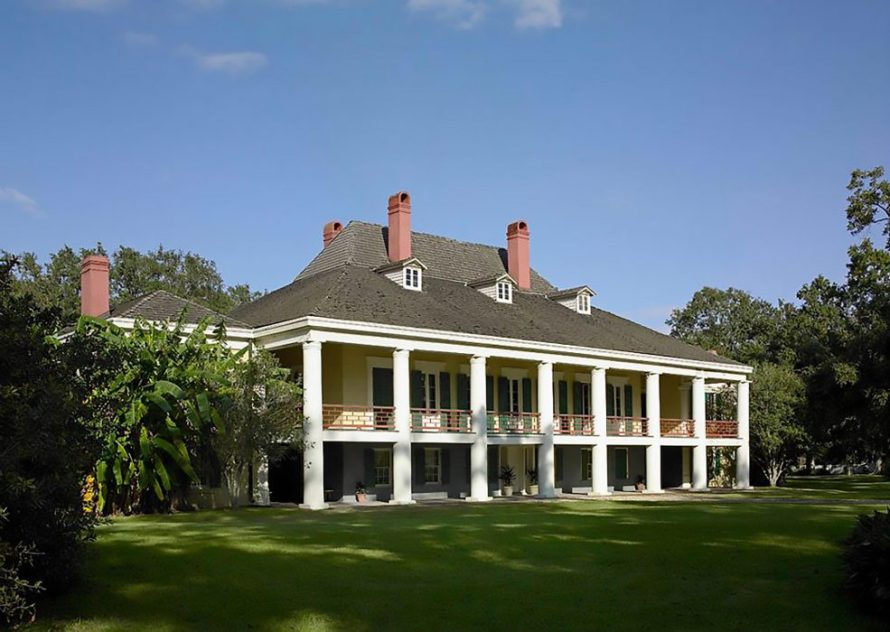
History and Importance
Destrehan Plantation, located in St. Charles Parish, is recognized as the oldest documented plantation house in the Lower Mississippi Valley, with construction beginning in 1787 under Robert Antoine Robin de Logny, a French Creole planter. Completed by 1790 during Spanish rule, it was meticulously crafted by enslaved carpenter Charles Pacquet, who earned his freedom in 1790 with a grant of rice, corn, livestock, and an enslaved man named Leveiller, a rare and documented act, recorded in parish archives. Jean-Noël Destrehan, born in 1759, married Marie-Celeste Robin de Logny in 1786 and purchased the estate in 1802, transforming it into a leading sugarcane producer by 1803, aided by his brother-in-law’s sugar granulation technique patented in 1795, a breakthrough noted in historical records. Destrehan was prominent in French colonial Louisiana and after the Louisiana purchase while serving on the territorial council advocated for statehood and helped craft the legal system. His political prominence as Louisiana’s first U.S. Senator from 1812 to 1813 elevated the plantation’s status, but his involvement in the 1811 German Coast Uprising trials—judging rebels like Charles Deslondes, leading to 18 executions held in the great house on January 11-13, 1811, as documented in trial records—marked a controversial chapter, influencing regional justice systems. The plantation faced economic collapse as sugarcane prices plummeted, passing to Pierre Adolphe Rost in the 1830s, who added Greek Revival elements like Doric columns and a grand staircase, with renovations completed by 1840. Post-Civil War, after 1865, the plantation served as a colony for freedmen and refuges to assimilate them into society providing self-sustaining agricultural collectives that also provided schools, commercial stores, and a hospitals. Destrehan had over 1,000 former enslaved people that passed through and recorded their names. Later the plantation declined further until the River Road Historical Society’s restoration began in 1971, opening to the public in 1972 as a best preserved Louisiana estate, with its historical significance recognized by the National Register of Historic Places in 1970.
13034 River Road
Destrehan, Louisiana 70047
Open 7 days a week except for major holidays
The first guided tour begins at 9:30 AM, with tours running every half hour until the final tour at 4:00 PM
Hotels near New Orleans Airport 20-40 miles from the River Road Plantations
2. Oak Alley Plantation: A St. James Parish Icon
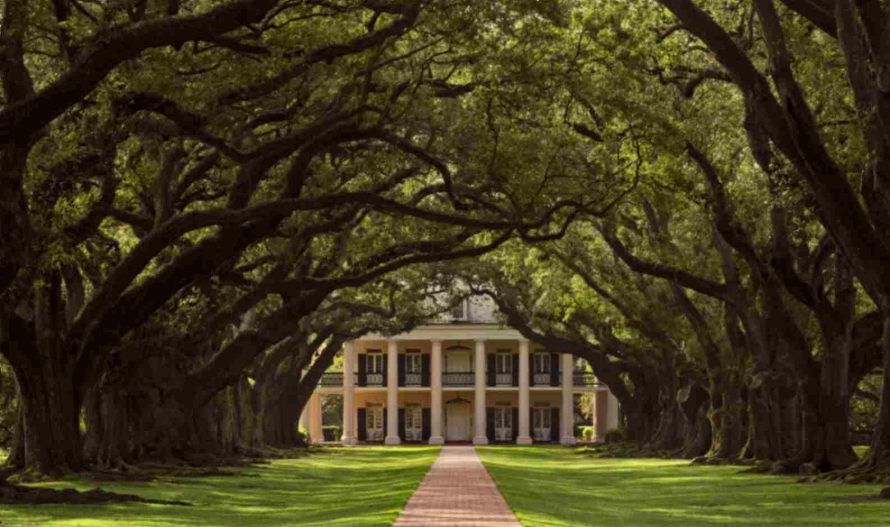
If you close your eyes and picture a plantation, chances are Oak Alley is what you would picture. The oak lined walk stretches from what was once the banks of the Mississippi River to the main house.
Oak Alley Plantation, built from 1837 to 1839 by Jacques Telesphore Roman ‘who bought the land from his brother in law Valcour’ Aime. When he bought the property there was a small house on the land and there were 3 pairs of oak tress that framed the house. When Roman built the mansion he lined the area from the house to the river with oak trees and today the plantation with its quarter-mile canopy of oak trees is the most photographed plantation in Louisiana. The mansion was constructed by enslaved laborers using brick and cypress, it thrived under Roman until his death on October 12, 1848, passing to his wife Celina Pilie Roman. Post-Civil War, after 1865, it declined under the Stewart family, acquired in 1917 by Andrew Stewart, until restored in the 1920s by Josephine Stewart, opening to the public in 1968 and gaining fame through Interview with a Vampire (1994), as noted in film credits. Its role in sugar production shaped St. James Parish’s economy, establishing it as a historic River Road plantations landmark.
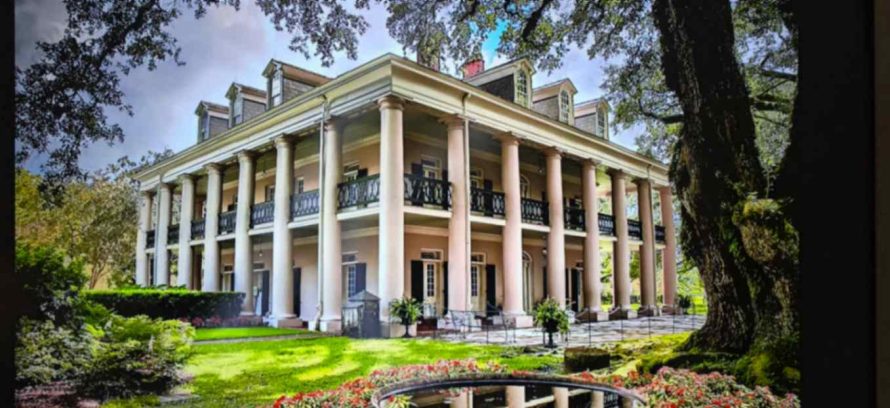
At its peak, Oak Alley enslaved more than 100 people. Plantation records detail names, birth dates, occupations, and even transactions. These records help humanize and individualize those who were once only counted as property. Today Oak Alley is one of the most visited plantations. There is a restaurant, event place as well as lodging available in cottages on the plantation grounds. I stayed one night at Oak Alley and was able to walk around after hours. Although the house and exhibits were closed at that time people spending the night have access to the grounds.
3645 Highway 18 (Great River Road), Vacherie, LA 70090
Open Daily: 8:30 am-4:45 pm except clo New Year’s Day, Mardi Gras, Thanksgiving Day, and Christmas Day
3. Laura Plantation: A St. James Parish Creole Gem
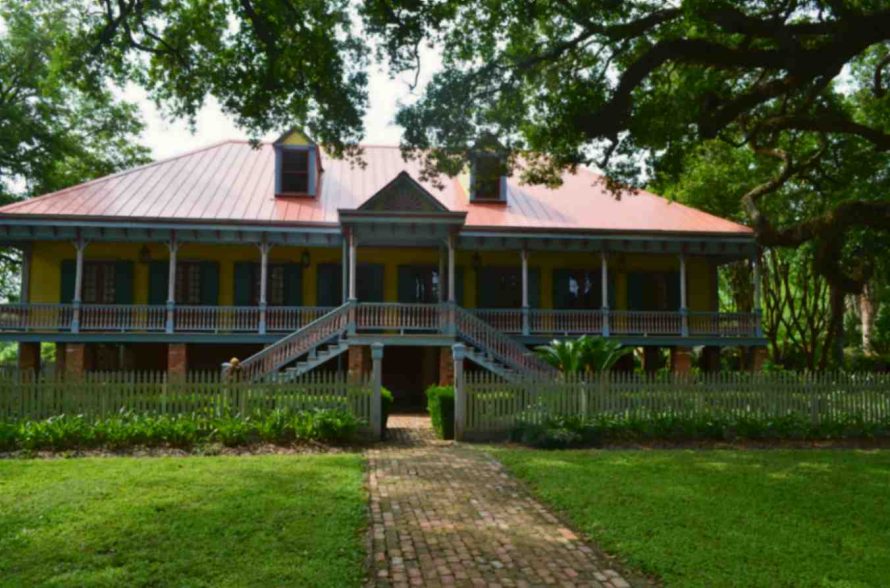
Laura Plantation offers one of the most authentically Creole experiences in Louisiana. Built in 1805, the house and grounds belonged to the Duparc-Locoul family, French Creoles who maintained meticulous records for nearly 200 years.
Unlike other plantations that focus primarily on grandeur, Laura is deeply rooted in oral histories, family letters, and personal memoirs, particularly those of Laura Locoul Gore, the last of her family to live on the plantation.
Laura Plantation, founded in 1804 by Guillaume Duparc and completed in 1805, thrived under four generations of women, beginning with Nanette Prudhomme Duparc after Guillaume’s death on September 15, 1816, from yellow fever. Its Creole-style home, painted in vibrant colors with a unique three-room-wide, one-and-a-half-deep layout, produced sugarcane. A fire destroyed part of the main house on October 4 2004, the home was rebuilt by 2006 with historical precision.. Managed by Laura Locoul Gore from 1879 to 1891, it reflects Creole resilience, a best preserved Louisiana estate recognized by the National Register in 1993. In 1936, Laura completed her handwritten, “Memories of the Old Plantation Home”, which became the basis of the personal stories told on plantation tours.
Open daily at 9:30 the last tour is around 3pm Closed on major holidays
2247 Highway 18
Vacherie, LA 70090
4. Houmas House: Ascension Parish
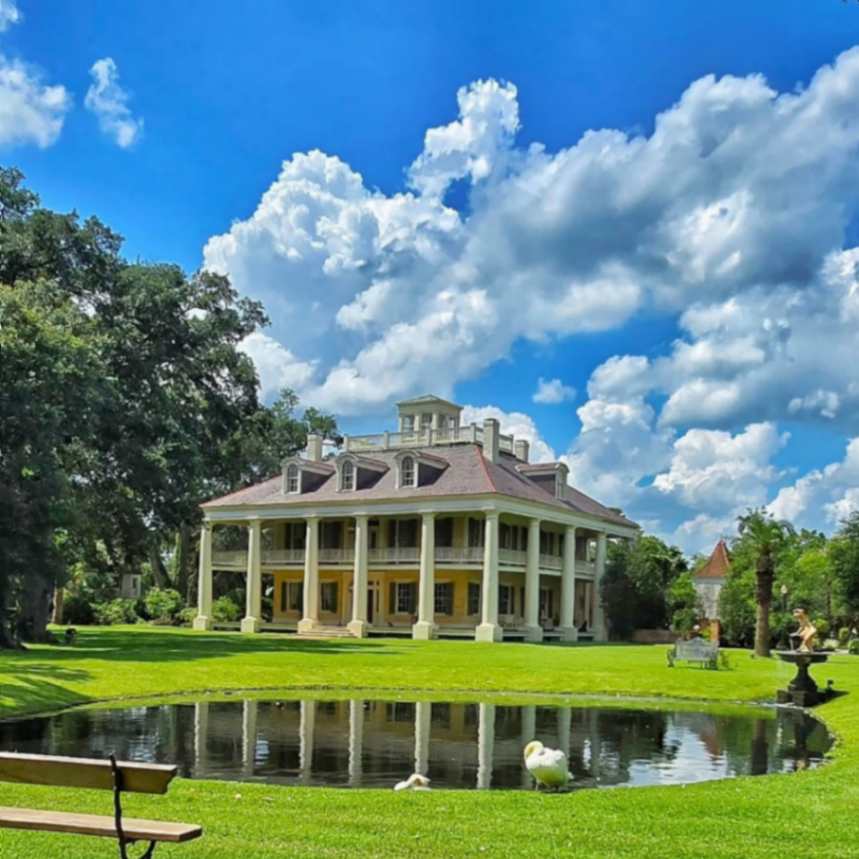
Houmas House Estate also known as Burnside Plantation was established in the 1700 with the main house you see today completed in the 1840’s. Houmas House has a rich history and has passed through many hands until businessman Kevin Kelley of New Orleans purchased the estate at auction in 2003 and began renovations. The estate has been placed in a foundation but remains the personal home of Kelley. The home, open to tours, has been restored with period pieces from the 1800’s and offers a glimpse of the opulence of those who owned the plantations. Houmas House leans heavily into the luxury and opulence of the antebellum era, with its extensive gardens, antique furnishings, and on-site museum. Several films have been shot at Houmas House including the 1964 movie Hush Hush Sweet Charlotte with Betty Davis. The property includes 8 buildings and covers 10 acres.
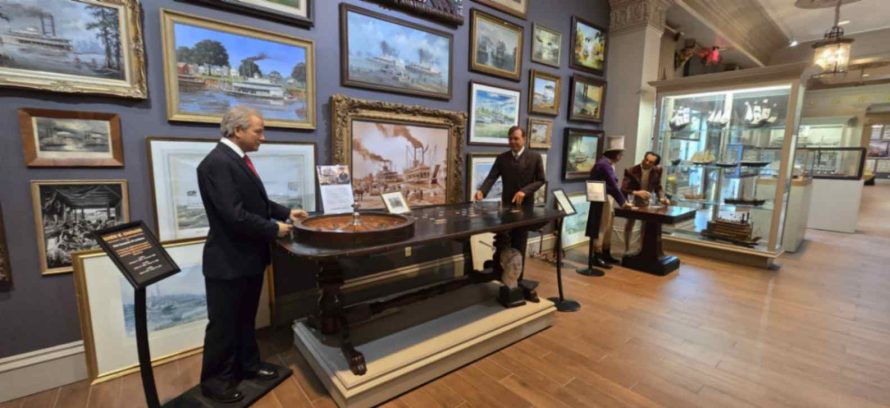
In addition to the Great River Road Museum, which tells the story of the area, there are extensive gardens, there are five restaurants, and cottages that you can rent for the night. Located on the Mississippi River, Houmas House is a popular stop for modern river cruises as well as tour buses.
Open daily 9am – 7pm, except Christmas and News Years day
40136 Highway 942, Darrow, LA
Other Notable Plantations on River Road
5. Whitney Plantation
Whitney Plantation and Historic District is operated by the Whitney Institute. Unlike other plantations in the area, Whitney Plantation focuses solely on the story of slavery. More of a museum, the plantation tells the story of slavery through memorials, artwork, restored buildings and first person narratives. The plantations offers self guided tours and offers visitors a look at the history and legacy of slavery.
Open 9:30 – 4:30 daily except major holidays
5099 Louisiana Hwy 18, Wallace, LA 70049
6. Evergreen Plantation
Evergreen Plantation is the most intact plantation complex in the South with 37 buildings on the National Register of Historic Places, including 22 slave cabins. Evergreen has been awarded Landmark status for its agricultural acreage. More than 400 individuals were enslaved at Evergreen Plantation over the course of 150 years. Established in the 1700’s, Evergreen Plantation has a extensive slave database and also offers an ancestry project which chronicles the life and stories of several former slaves.
Tours offered thru a private company (504) 251-1595
4677 LA-18
Edgard, LA 70049
7 & 8 St Joseph Plantation/Felicity Plantation
St Joseph Plantation and Felicity Plantations are sister plantations located in Vacherie Louisiana and still operate as working sugarcane farms. St Joseph, built in the 1830’s and Felicity, built in the 1840’s are both available for tours. In addition you can visit the sugarcane museum, other historic buildings and original dwellings of the enslaved. The plantations have been a setting for several movies and tv shows over the years.
Open 7 days a week
Tour Times:
St. Joseph: 10AM, 11AM, 12PM, 1PM, 2PM, 3PM
Felicity- 9:30AM, 10:30AM, 11:30AM, 12:30PM, 1:30PM, 2:30PM, 3PM
For those planning a road trip along the Great River Road in Louisiana, these plantations offer opportunities to learn, reflect, and experience the layered narratives of the American South. Most sites are within 30–60 minutes of New Orleans, making them ideal for day trips.
Final Thoughts: Why Plantation Preservation Matters
Plantations are complex spaces. They were homes, businesses, and sites of immense suffering and resilience. To understand America’s past, especially the development of the South, we must engage with these histories—even the painful ones.
Preserving plantations isn’t about glorifying the past. It’s about understanding it in its fullness, honoring all the people who lived and labored there, and using that knowledge to build a more empathetic future.
When you walk the shaded paths of Oak Alley or listen to a guide at Laura tell stories of Creole women and enslaved children, you’re not just touring a home. You’re engaging in the act of remembrance. And that is something worth preserving.


Leave a Reply